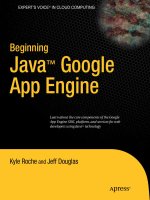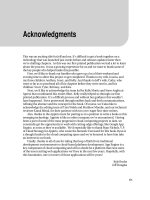Apress bắt đầu ứng dụng với java google - p 2 doc
Bạn đang xem bản rút gọn của tài liệu. Xem và tải ngay bản đầy đủ của tài liệu tại đây (749.62 KB, 10 trang )
■ CONTENTS
ix
Adding Your Styles 107
Modifying Your Hosted Page 107
Running Your Application 108
Handling Client-Side Events 108
Summary 121
Chapter 6: Authenticating Users 123
Introducing Google Accounts 123
Restricting Access to Resources 124
Users API 125
Development Mode 126
Adding Authentication for Your Application 127
LoginInfo Class 128
LoginService and LoginServiceAsync Interfaces 129
Google Accounts Login Implementation 130
Modifying the Deployment Descriptor 131
Modifying the User Interface 131
Summary 133
Chapter 7: Using the App Engine Datastore 135
Introducing the App Engine Datastore 135
Working with Entities 136
Classes and Fields 137
CRUDing Entities 143
Performing Queries with JDOQL 145
Filtering Queries 146
Sorting Queries 147
Query Ranges 147
Using Indexes 147
Building Indexes 148
Creating Indexes In Development Mode 148
■ CONTENTS
x
Using Transactions 149
Finishing Up Your Application 150
Making Remote Procedure Calls with GWT RPC 150
Creating Your Data Service 156
Modifying the Deployment Descriptor 161
Invoking the Service from the GWT Client 161
Displaying Timecard Entries 166
Summary 168
Chapter 8: App Engine Services 169
Setting up the Project 169
Memcache Service 171
URL Fetch Service 175
Images Service 178
Creating the Java Classes 179
Writing the ImageObject Class 180
Writing the PersistenceManagerFactory Class 182
Writing the ImageSource Class 182
Writing the ImageTransform Class 183
Completing the Application 186
Testing the Service 187
Mail API 189
XMPP Service 192
Summary 195
Chapter 9: Administration and Integration 197
Managing Your App Engine Application 197
The Application Dashboard 199
Application Versioning 203
Analyzing Log Files 204
■ CONTENTS
xi
Integration 206
Integration with Google Wave 206
Integration with Salesforce.com 214
Summary 218
Index 221
■ CONTENTS
xii
xiii
Foreword
You’ve just picked up a book on Google App Engine. Welcome to the ground floor of a
critical component in our industry’s shift to cloud computing.
It’s not an exaggeration to say that the development of consumer and enterprise
applications has been completely transformed by the emergence of cloud computing
over the past several years. First came a revolution in application delivery—the idea
that applications could be delivered as a service over the Internet, without any
software to install or maintain. Then came a revolution in application
infrastructure—the idea that developers could consume raw computing and storage
capabilities as a service, without any physical infrastructure to deploy or maintain.
Now we’re seeing a revolution in application platforms—giving developers the
ability to build applications using higher-level building blocks, without needing to
know about the underlying physical machine. App Engine is Google’s entry into this
world of on-demand application development and deployment, and represents a
major contribution in this shift to the cloud. Here’s why App Engine is so important:
1. Development without worrying about deployment infrastructure
Most application development projects require a lot of time for planning the
development and deployment stack. Which app-server container, database server,
and load balancer should you use? Do you have enough licenses to deploy? Is your
app going to share an existing database or do you need to spin up a new instance?
How will you back up and monitor the performance of the app? Do you have enough
CPU, data, and network resources to adequately scale your app? All these questions
had to be answered before you could write a single line of code. Google App Engine
changes all that. Google provides a complete development and deployment stack,
and you can start developing with no up-front cost. Google does the heavy lifting,
allowing you to focus on the specific needs of your users.
2. Single development environment, end to end
Database development, application development, and UI development have
traditionally been done in completely different environments, often by completely
different development teams. With App Engine’s integration with Google Web
Toolkit, you can download the SDK, install the Eclipse plug-in, and start to code your
entire application in a single environment. You can build your UI directly in Java,
■ FOREWORD
xiv
connect it to App Engine Java Data Objects, and debug everything end to end, all
from within Eclipse.
3. Instant deployment, cloud scalability
Traditional application developers allocate up to one third of their total development
time to deployment into a production environment. Your first App Engine app will
deploy from your local development environment to Google's world-class, cloud-
scale production infrastructure, all with a press of a button. And your application can
scale from its first user to its millionth user with complete elasticity, literally running
on the same infrastructure as the highest traffic sites on the Internet.
The implications?
Given Google App Engine's new capabilities, we've been excited to add it to the set of
tools that we use at Appirio to help our enterprise customers do more with the cloud.
App Engine fills a recognized gulf between the two leading cloud platforms, Force.com
and Amazon Web Services. Force.com is a rich business application platform with built-
in business objects that allow applications to inherit a broad swath of functionality. But
some applications don't require this functionality and would benefit from having greater
control and direct access to "lower levels" of the platform. At the other end of the
spectrum, Amazon Web Services, in particular S3 and EC2, give application developers
the power to control their own infrastructure without the headaches of hardware
ownership. But many applications don't require this level of control of the infrastructure;
a higher level of abstraction would make development much more efficient.
We see Google App Engine as filling the void between these two leading
platforms. App Engine offers more control than you get from working in a Force.com
environment. And App Engine offers abstraction over several layers of infrastructure
that we'd prefer not to deal with in the applications that we build today on EC2, so,
for example, we don’t have to worry about the size of the machine we spin up.
The best part is that these technologies are almost completely complementary,
and toolkits exist to ease their interoperability. At an event this year, someone posed
the following question: “Is the industry on the verge of a new set of platform wars? Or
will all the different cloud platforms create an interwoven fabric of web applications
that draw from each cloud as is convenient?" We believe firmly in the latter. After all,
the real “platform war” is still against the old paradigm. Most developers out there
don’t know that they don’t need to buy hardware and software anymore in order to
develop and deploy world-class web applications.
But you will. Enjoy this introduction to the new world of developing on Google’s
App Engine. We look forward to seeing the applications that you develop!
Ryan Nichols
V.P. Cloud Strategy, Appirio
xv
About the Authors
■Kyle Roche has been working in the cloud-computing space
since 2005. Professionally, Kyle has over 10 years of experience
in the enterprise software space. With deep roots in application
architecture and systems management he quickly recognized
cloud computing as the future trend and has since led some of
the most progressive cloud-development efforts to date for
companies like Salesforce.com, Starbucks, and JP Morgan Chase.
Kyle is a regular speaker at industry conferences and user-group
meetings and is an evangelist for cloud computing. His personal
website is .
He lives in Denver with his wife Jessica and his three children Aodhan, Avery,
and Kelly.
■Jeff Douglas is a highly sought-after and award-winning
technologist with more than 15 years of leadership experience
crafting technology solutions for companies of all sizes. His
technology skills were honed during the fast and furious “dot
com era,” when he provided SAP development services for
Fortune 500 companies including Coca-Cola, Anheuser-Busch,
Disney Imagineering, Moen, and Ericsson. After years of being a
lowly Java developer, in 2006 he ascended into cloud computing.
He periodically writes for developer.force.com and actively
tries to work the word "chartreuse" into everyday technical
conversations. He speaks at industry conferences and enthusiastically blogs about
cloud computing at .
Jeff resides in Sarasota, FL, with his wife Cathy and four children Scott, Tyler,
Brittany, and Kira (adopted). He and his wife have been medical foster parents for
over 11 years, caring for more than 75 children.
Kyle and Jeff both work for Appirio, a cloud solution provider that offers both
products and professional services to help enterprises accelerate their adoption of
■ FOREWORD
xvi
the cloud. With over 2,500 customers, Appirio has a proven track record of
implementing mission-critical solutions and developing innovative products on
cloud platforms such as Salesforce.com, Google Apps, and Amazon Web Services.
From offices in the U.S. and Japan, Appirio serves a wide range of companies
including Avago, Hamilton Beach, Japan Post Network, Ltd, Pfizer, and Qualcomm.
Appirio was founded in 2006, is the fastest growing partner of Salesforce.com and
Google, and is backed by Sequoia Capital and GGV Capital.
■ ABOUT THE AUTHORS
xvii
About the Technical Reviewer
■Kunal Mittal serves as an Executive Director of Technology at
Sony Pictures Entertainment where he is responsible for the SOA
and Identity Management programs. He provides a centralized
engineering service to different lines of business and consults on
the open-source technologies, content management,
collaboration, and mobile strategies.
Kunal is an entrepreneur who helps startups define their
technology strategy, product roadmap, and development plans.
Having strong relations with several development partners
worldwide, he is able to help startups and large companies build
appropriate development partnerships. He generally works in an advisor or
consulting CTO capacity, and serves actively in the Project Management and
Technical Architect functions.
He has authored and edited several books and articles on J2EE, cloud computing,
and mobile technologies. He holds a Master’s degree in Software Engineering and is
an instrument-rated private pilot.
■ FOREWORD
xviii









